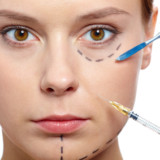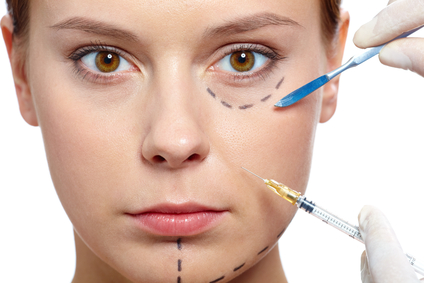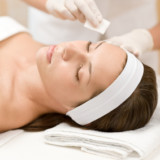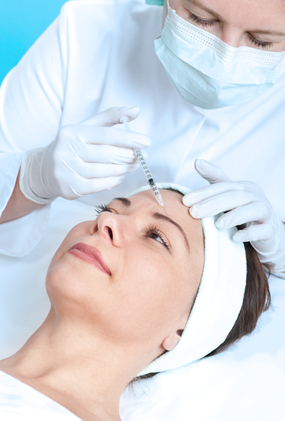Voluma vs Botox – Which Better?

No doubt you have heard of dermal fillers like Botox and Juvederm for turning back the hands of time. It is advertised on TV so even if you have not had the treatments yourself you have at least heard of them or know someone who has had treatment with one of them. Now, there is a new product joining the ranks of the top products for erasing the signs of aging.
 Our bodies age at different stages. The skin on your face ages faster than some of your body parts, and we don’t feel as young and energetic as we used to. If you smoke or drink alcohol, or spend a lot of time outdoors in the sun that can cause you to age quicker as well. Those worry lines are there for a reason, it’s from all that time spent worrying about how you look.
Our bodies age at different stages. The skin on your face ages faster than some of your body parts, and we don’t feel as young and energetic as we used to. If you smoke or drink alcohol, or spend a lot of time outdoors in the sun that can cause you to age quicker as well. Those worry lines are there for a reason, it’s from all that time spent worrying about how you look.
Voluma restores the fullness of the cheeks, producing a firmer, smoother skin surface to lift sagging skin and make you look years younger. Voluma is the first HA (Hyaluronic acid) injectable filler to get the FDA’s approval for filling in the cheeks and creating the lift that makes the hollows practically disappear.
Voluma XC may resemble every other dermal filler in existence today, but it’s got a unique quality. While Voluma is used mainly to reduce lines and wrinkles, it can also change the shape of the face.
For young faces, there is a curved fullness around the center of the face. In an older person, this same area may look hollow and sunken in. This is where the injection of Voluma comes in.
What does the XC stand for?
XC in the name indicates that the filler contains lidocaine, an anesthetic to reduce pain and discomfort at the injection site. The syringes with lidocaine hold 25% more than those without it. If you are unsure, ask your doctor to see it or the box to make sure of what you are getting.
What’s the difference between Voluma and Botox?
Botox smooths the surface of the skin to erase lines and tiny wrinkles like crow’s feet. It is also good for the lines around the nose and mouth. Voluma adds roundness and fullness to the cheeks. They both work in similar ways and can actually be used together for different areas of the face to make you appear younger.
What you need to know about Juvéderm Voluma
The active ingredient in Juvederm Voluma is hyaluronic acid, a substance naturally produced by the body that diminishes as we get older. Voluma contains lidocaine to numb the injection site and the results can last as long as two years. It was first developed in Europe in 2005 without the lidocaine. It was then added four years later, in 2009. By 2013 it had obtained FDA approval and was available for use in 72 countries. The benefits are that it is less expensive, and because it is a non-surgical treatment it doesn’t have all the risks of surgery.
Side Effects of Voluma
Voluma is a non-surgical treatment. It is less risky than surgery but it does have a few side effects worth noting. Of the ones reported, they are mild and temporary and may include:
● Swelling or pain at the injection site
● Firmness or lumps in the skin
● Bruising, redness, or itching
Your doctor will offer suggestions to help reduce any discomfort you may experience following your injection. These suggestions will likely include avoiding cosmetics, excessive sun exposure or intense heat like that found in steam rooms, saunas or hot showers. For more information about what you can expect to experience in the days following your treatment with Voluma, talk to your doctor.
Talk to your doctor about treatment with Voluma and what to expect. He or she can answer any questions you may have and offer suggestions to make the treatment go smooth. There are things you will need to avoid, like wearing makeup, sunlight, and exposure to heat for a few days following treatment.
Botox for Treatment of Cervical Dystonia

 Cervical dystonia, also known as spasmodic torticollis, is a neurological condition involving spasms that produce repetitive contortions in the neck muscles making it difficult for the person to hold their head up.
Cervical dystonia, also known as spasmodic torticollis, is a neurological condition involving spasms that produce repetitive contortions in the neck muscles making it difficult for the person to hold their head up.
The condition is exceedingly painful and impairs normal motion. It can affect people of any age but women in their 40’s are affected twice as much as men. The symptoms appear gradually and spasms may be sporadic.
How is it treated?
While there are medical specialists that treat cervical dystonia such as neurologists and physical therapists, the treatment most frequently used is Botox injections. It works so well in fact, that it is the only treatment that is needed to help them manage their symptoms. There is no cure for the condition, but Botox is effective at treating it.
Botox is injected into the muscles in the neck and shoulders to control the spasms and odd head position common with the disorder. With most patients, the effects last for about 3 months. Exercises that stretch the neck muscles and a therapeutic brace used in combination with Botox therapy are sometimes helpful in easing some of the symptoms. Surgery is often recommended for the most severe cases that do not respond to treatment. In those cases, the nerve leading to the affected muscle can be severed creating a lasting solution to the problem but surgery carries risks and is considered only as a last resort.
A major clinical trial conducted recently noted that a large percentage of people who were given Botox injections for the treatment of cervical dystonia saw a remarkable improvement in neck movement, head posture, and decreased neck pain. They were able to resume their normal activities without pain.
The results of Botox include:
- Corrects head and neck position
- Enables performance of routine activities
- Relieves or eliminates neck pain from muscle contractions
- Some patients may need multiple doses and results may vary from person to person
The muscle spasms and painful contractions are the result of the over-stimulation of the nerves leading to the neck muscles. Botox is injected in the muscles of the neck blocks these nerves and the pain signals from these nerves. The pain and symptoms are eliminated for 3 months at a time.
Botox is often recommended in combination with physical therapy and prescription medications. Surgery offers a more permanent solution but is also riskier and reserved only in cases when the patient does not respond to other treatments. Ask your doctor what is the best treatment for cervical dystonia, and if Botox treatment may be right for you.
Botox Treatment for Chronic Migraine

Botox has been used for a number of years to treat chronic migraines headaches. It has been used for this purpose since 2010 when it was granted approval by the Medicines and Healthcare products Regulatory Agency (MHRA). It is not approved or short-term or infrequent migraines and cluster headaches.
 What is it?
What is it?
Botulinum toxin is a neurotoxin that is derived from Clostridium botulinum. There are actually several variations of the substance, with a diluted solution that has become a widely known product for diminishing wrinkles. How it works is that it freezes the muscles by blocking acetylcholine at the neuromuscular junction causing temporary paralysis. It is highly effective at treating muscle spasms which is why it works so well for migraines.
Botulinum toxin and headaches
Botox was not originally intended for the treatment of headaches, but several people who were using it for other things noticed that the frequency of their migraines was greatly reduced when they began treatment. It was first tested on tension headaches but had no real positive results. Several studies later concluded that it was most effective when used in patients with persistent migraine headaches.
The Botox migraine trials
A Phase 3 Research Evaluating Migraine Prophylaxis Therapy (PREEMPT) study was performed using 1,384 migraine sufferers. Participants were given botox and a placebo in a randomized trial for a period of 56 weeks. Of the participants that received Botox injections, they reported having fewer than 8 headache days per month. Prior to the study, participants reported experiencing more than 20 headache days per month. Results were obtained after two injections, by the end of the study, 70% of participants reported only experiencing half as many headache days as before. Side effects were minimal and temporary.
How does botulinum toxin relieve chronic migraines?
The exact mechanism is not known, but in general, Botox works by blocking the impulses to the muscles. In migraine, it is believed that Botox works by blocking the neurotransmitters that trigger migraines.
Is Botox right for you?
Chronic migraine sufferers with at least 15 headache days per month are eligible to receive treatment with Botox. There are other treatments available if you do not qualify, so talk to your doctor to find out about other options available to you.
Who can administer Botox injections?
There is no one designated place to get them. Just make sure that the doctor you choose is properly trained to administer Botox injections and is experienced in managing migraines and follows the PREEMPT guidelines and procedures.
The doctor should take down your medical history, and a full record of when the headaches began, the frequency and intensity, triggers, and any prescription medicines you may have taken before to treat them. You’ll need an accurate diagnosis prior to treatment.
Traditional VS Non-Surgical Facelifts

 Non-surgical facelifts are an effective way to get rid of wrinkles and slow the signs of aging without the risks associated with surgery and the downtime required for recovery. This new process is safer, has almost no downtime, and is practically painless.
Non-surgical facelifts are an effective way to get rid of wrinkles and slow the signs of aging without the risks associated with surgery and the downtime required for recovery. This new process is safer, has almost no downtime, and is practically painless.
One benefit is that it only takes about 30 minutes and can be done right in your doctor’s office. A local anesthetic numbs the pain so that you won’t feel any discomfort and can resume your normal activities right after treatment. You may have a little bruising and swelling but that only lasts a short time, depending on your skin and how it reacts.
Is it safer to have a non-surgical facelift?
Any time you have surgery you run the risk of infection, scarring, and in extreme cases, paralysis. If it goes bad you may have to have another procedure to correct the damage done by the first one. And then there is the recovery time. It can take up to 2 months for it to heal and you will need a prescription for painkillers to deal with the pain and swelling that goes along with it.
A non-surgical procedure does not involve any surgery, you will have only minor redness and a little bruising at the injection site, but no need for prescriptions or pills and you can go right back to what you were doing before.
How are the results different?
Well, with a traditional facelift the results will last for a few years. But the downside to that is you may have tell-tale signs that you have had a facelift. If the results are very dramatic you may look like a totally different person, meaning that people won’t recognize you if it is really extreme. In some cases this is good, but in most cases, it is not.
The results you get with a non-surgical facelift are more subtle and natural-looking. You will look like you, only a younger version of you. Nothing on your face will look any different. You just won’t have the lines and wrinkles you had before.
Is there a difference in cost?
A surgical facelift will cost between $5,000 and $8,000. Depending on where you go, the cost could be higher. And if there are complications the cost will rise even more. Non-surgical facelifts are much lower in cost, around $800 but may be a little bit more depending on what all you are having done.
Non-surgical Facelift Options:
The options for non-surgical facelifts include Botox and other dermal fillers that eliminate the fine lines and wrinkles by plumping up the skin and stimulating collagen production to smooth out the skin making it tighter and more youthful in appearance.
- Restylane is a dermal filler approved by the FDA to help eliminate folds and wrinkles in the skin. The results last from 6 months up to 1 year.
- Hydrelle is the first hyaluronic acid dermal filler with lidocaine approved by the FDA. One treatment with Hydrelle can decrease wrinkles for up to 1 year.
- Juvederm is a gel-type dermal filler that promotes a smoother look to the skin. Juvederm contains the highest concentrations of hyaluronic acid. The effects often last 6 months or longer.
- Perlane is a cosmetic filler that restores fullness to the skin, correcting moderate to severe skin folds and wrinkles.
- Radiesse is a dermal filler often used for facial contouring. It mainly consists of calcium hydroxylapatite which is similar to human bone. The effects last longer compared to the other types.
The dermal fillers work by attracting more moisture to the skin giving it a plumper, more hydrated appearance. When the skin is firmer, it smoothes out those wrinkles and makes you look years younger.
Botox vs Dysport: Which is the Better Option?

There is nothing noble about aging gracefully. We all want soft, smooth wrinkle-free skin for as long as it is possible. Some people are naturally gifted with a youthful appearance, but if you are not one of those lucky few, you can still beat father time by investing in anti-aging treatments to build up the collagen and smooth those wrinkles and laugh lines away.

There are several factors that will determine how your skin looks as it ages. Genetics has a lot to do with how we look as well as the food we eat, how much exercise you get, and how many hours you sleep every night. All of these things can contribute to wrinkles if you’re not careful. Out of the many products on the market for smoothing out fine lines, wrinkles, and crow’s feet, two products are recommended most often: Botox and Dysport.
These two products are very similar in what they do, so it just comes down to choosing one. Here is a little bit of information on both of them:
Botox and Dysport are both made up of neurotoxins that temporarily restrict the muscles in the area being treated.
Dysport or Botox – Which one should you choose?
Botox is comprised of a form of botulinum toxin that freezes the muscle movements in the area treated such as the fine lines around the mouth, forehead furrows, and crow’s feet around the eyes. The difference between Botox and Dysport lies in the area of how many units of each are required to do the same job and how long the effects last.
From clinical reports, we know that Dysport gives quicker results than Botox, but it tends not to be as long-lasting. Further testing is needed to determine which of the two lasts longer, but it is suspected that Dysport may come out ahead in this department.
Because Botox contains significantly larger amounts of protein, it is very probable for the body’s immune system to kick in and fight any foreign particles entering the body. Dysport, with a much diluted quantities of protein, makes it easier for the body to not retaliate the injections.
Botox contains a large amount of protein, which can sometimes trigger an immune system response to kick in and attack the foreign invader. Dysport, while it is the same protein as Botox, has it in a diluted form making it easier to be accepted by the body. The body does not reject it other attack it, so it is often the better choice of the two in this area. It also works better for treating large areas as it spreads out in the system so you do not need to use as much for the same effect.
Just to give you an idea of what the cost is, 10 units of Botox runs about $52.50. The same amount of Dysport will cost around $6. While Botox has been around a lot longer, Dysport is proving to be a pretty good contender for that #1 spot.
Botox vs Xeomin: Which is Better?

When comparing two very similar products it is often difficult to say which is the better of the two. Both Botox and Xeomin are type-A Botulinum toxins. They are alike in that they contain some of the same ingredients and come in similar packaging. Similar, but different.

Where the difference comes in is that Botox contains an accompanying protein that detaches itself after being injected, and Xeomin does not. It is a purer type due to not having this other protein with it. The effects, however, are pretty much the same. So again, similarities and differences.
Both are used to treat:
● Crow’s feet
● Forehead lines
● Frown lines
One thing that Xeomin is very good for is the glabella wrinkles (furrows between the eyebrows). Its effectiveness has been proven in the US and Europe for this purpose. For the most part, Botox, Xeomin, and Dysport are all similar products. They are all type-A neurotoxins and produce very similar results. The differences between the products are in how much is needed to produce the same results.
For instance, it is only an estimation that “it takes one vial of Xeomin to produce results equal to the same amount of Botox”, or that it takes “two times as many vials of Dysport to have the same effect as a single unit of Botox.” These estimates are not an accurate predictor of success. They are just guidelines when it comes to accurate dosing. One patient may need more or less than another.
The results of both Xeomin and Botox are temporary. Both wear off over time and the nerve impulses are restored. Both treatments require repeated applications every 3-6 months to maintain the results.
If you have tried Xeomin but did not achieve the results you wanted it may not be that it didn’t work, but that you needed a larger dose to be effective. Again there are factors that are different for every person so it is very difficult to predict how well it will work.
The differences with Botox and Xeomin is that there is less chance of an allergic reaction due to not having the additional protein, it does not have to be refrigerated (shelf-stable) and may be better tolerated by people sensitive to Botox. The additional protein in Botox may be what makes it last longer because it takes longer to be metabolized in the body.
How Long Does Botox Last?

Are you considering using Botox as an anti-aging treatment? Well, there’s good news and bad news. The bad news is, of course, that the effects don’t last forever. You have to keep using it to keep the wrinkles away. The good news is, it’s not in short supply. It will be around for a good long time, no worries. And if you happen to get a treatment from someone and don’t like how it turned out, you only have to wait a few months for your skin to return to normal after the effects wear off.

Exactly how long do the effects of Botox last? It depends on how much was used and how much of it was applied to the treatment area. The dose will vary by person, and that may be a factor as well. It may last longer for one person than it does another.
You might think that it would be accurate to simply guess how many vials would be needed for the face, but each area requires a certain number of vials and everyone is different. There are 43 muscles in the face, to be exact. So it is not accurate to make an educated guess.
To show you an example of this, the tiny lines at the outer corner of the eyes (crow’s feet) will usually require 8 to 14 units for each side. The group of muscles around the forehead (the area between the eyebrows) called the glabella area – usually require 18 to 36 units to smooth them out.
The effects are different for everyone. If you have thicker muscles, you will most likely require more than someone with thinner muscle. It is not acceptable to go deeper when injecting someone with thick muscles. Every injection must be precise and meet the same standards of quality.
The effects may wear off faster for those who tend to be more athletic. People who are active will heal quicker and therefore it will be eliminated out of their system faster as well.
Repeated Treatment Yields Better Results
Some more good news is that regular use of Botox produces better results and the effects last longer. Every time an injection is given it relaxes those muscles in the treatment area allowing them to get weakened from not being used which makes the Botox work even better. The effects last longer and new wrinkles are prevented since those muscles are not in use.
If you don’t see the results you want it may be because you are not taking the right number of treatments. The more it is used, and the more consistently it is used, the better the results will be. Botox is best for fine lines and wrinkles around the eyes and mouth area. Deep-set wrinkles may not respond the same way as the lighter ones.
So then the question, how long does Botox last? When it is administered properly and injected into the right places, you can expect to see results lasting 3 to 4 months. Again this will vary from person to person, and it may last longer with consistent use. It is a good estimate to say between 3 – 6 months for most applications.
Some things that can affect how long Botox lasts includes:
● Metabolism
● Your age
● Treatment area
● Dilution of the product
If you received Botox treatment that did not last as long as you expected to take the initiative to try and find out why. It may be because the doctor didn’t use enough or it was not properly injected into the muscle tissue.
Many patients notice some minor results within three to five days after treatment, and then get the full effect after 14 days. This may vary slightly as it depends on how quickly your body metabolizes the Botox. Your doctor may request a follow-up appointment to see your progress.
Cost of Botox Injections

One of the most popular anti-aging treatments on the market today is Botox. It is frequently chosen as an alternative to facelift surgery. Making the decision to get the injections requires an understanding of how the costs are calculated and how many treatments will be needed overall.  Some doctors charge different prices based on the location of the injections and unit costs. Here is a quick explanation of the costs of use over time.
Some doctors charge different prices based on the location of the injections and unit costs. Here is a quick explanation of the costs of use over time.
Pinpointing an exact price for Botox is difficult as the costs will vary by states and geographical location. A general estimate of between $200 and $400 per treatment is to be expected in most areas. The price could be a bit higher if there is competition in the area. For example, one lady was charged $350 for her treatments based on the average price of the services in her area. She felt very confident that she had chosen a qualified doctor and the price was acceptable.
If the price is based on units, the average cost of a unit is $9-$12, or $200-$300 per area using multiple units. This cost is multiplied for every area being treated. For example, you may need 20 units just to do your forehead and 5-6 units for those pesky crows feet. The frequency of treatments is usually every 3 months.
That does not mean that this is the average price for all Botox treatments. This was the average cost in that area. The price in your area may be less for the same number of injections. Some research will be needed to determine whether the cost is something our budget can handle.
Price May Change over Time
Another consideration is that the prices may change off and on. Just like anything else, the costs of Botox and other dermal fillers will fluctuate and may rise or fall depending on the season and other factors. Your cost may change if you require fewer treatments or the frequency of your treatments may change. You may only require a couple of treatments to smooth out those beginning wrinkles and fine lines.
Regular injections of Botox help those fine lines go away and prevent the formation of new ones. It helps too if you avoid facial expressions such as frowning that accentuate the lines around your mouth and the furrow between your brows.
When injections are done regularly, the effect is long-lasting and prevents wrinkles in the area being treated. Botox restricts the movement of muscles in the treatment area which helps you avoid creating new lines and wrinkles such as the ones you’re trying to eliminate.
Once you have begun Botox treatments remembering to relax your facial muscles and keep from frowning will become a secondary habit. It may even help you to need fewer treatments to maintain your skin’s youthful new look.
Regulations for Use of Dental Botox

Dr. Howard Katz pioneered the use of Botox in dental practice but many states still have outdated laws on the books. While its use is beneficial, not every state allows it and the ones that do have limitations. Current regulations for dental applications of Botox and dermal fillers vary from state to state. The following is a partial summary of the law defined by dentists in the following 27 states:
The use of Botox in dentistry is limited to oral and maxillofacial surgeons that have completed an extended residency in the states of Virginia and Mississippi.
Florida, Idaho, Iowa, Alaska, Nevada, New Hampshire, New York, Connecticut, Kansas, Maryland, North Carolina, Texas, Washington, West Virginia, and Wisconsin allow the use of Botox by dentists who have completed an intensive course of study by the American Dental Association and restricted applications to treatments only.
In the states of Louisiana and Arkansas, the use of Botox is permitted by dentists who have completed a study course accredited by the American Dental Association and covering topics such as assessing patients, its uses and contraindications, the side effects and potential risks, preparation, treatment, therapeutic uses, and hands-on use with patients. The law also restricts use to dentists only and must be administered in-office. It also forbids use by hygienists and dental nurses.
Massachusetts, South Carolina, South Dakota, and Wyoming, New Mexico, and Pennsylvania presently has no regulations regarding the use of Botox by dentists.
Delaware is the only state that is choosing to be neutral and is making no recommendations either way. The state currently treats reported violations on a case-by-case basis. The Board of Dentistry and Dental Hygiene for Delaware is taking no position at all in regards to the use of Botox in dentistry.
On a final note, training programs for Botox from an accredited program of study are a requirement for some malpractice insurance carriers. Check the laws in your state for more clarification.
Proven Dentox Injectables Course Arrives In Manhattan!

Here’s something great for the future of your career and your practice: The powerful and proven Dentox injectables course is coming to Manhattan, giving New York dentists and doctors the opportunity to learn from the inventor of Botox and dermal filler training – conveniently in the New York City area.
Keep reading for all the details – or skip along if you like and you’ll find the important dates and times. First, however, let’s seriously discuss what this course offers.
The course is a unique educational opportunity that isn’t available in Manhattan often, so you don’t want to miss your chance. It’s Botox and dermal filler training and much more that can help you build a successful medical aesthetics practice or grow a sideline in your established medical or dental practice.

Learn About PRP From A Master
Maybe the most exciting of the opportunities available in the latest version of the Dentox one-day injectables training program is the module on Platelet-Rich Plasma therapy – or PRP. This innovative therapy is growing in popularity to the point that medical aesthetics clinic clients are starting to ask for it. You don’t want to be left behind when you can, in fact, get ahead.
In addition to being an exceptionally effective way to fill lines that’s much less expensive than dermal filler products, PRP can also be used to help patients recovering from injuries or surgery recover more quickly.
Here’s how it works, if you aren’t familiar with it: Using a special centrifuge – a one-time expense for you – a patient’s blood is transformed into a product that can be injected to fill line, improve healing speed and even help with bone regeneration. As a healing tool, it’s unmatched. As a filler, it’s less expensive to produce and use than dermal fillers and carries no risk of allergies. That means you can use it safely while both you and your patient saves money.
Because PRP therapy is a recent innovation, there are very few places or ways to learn it. The Dentox Botox and dermal fillers class now includes a complete module on PRP therapy comprehensive enough that you can start using this therapy in your office immediately after your training.
And remember, this remarkable therapy is just one part of your Manhattan Botox training course. But before we discuss the other topics that will be presented, however, let’s take a look at the schedule so you can see how much time is devoted to each topic.
Hands-On Manhattan Injectables Training Schedule
When you choose Dentox for your Manhattan injectables training course, you’re choosing a comprehensive one-day course that follows this strict schedule:
8 am to 11 am: Botox Training, the heart of the seminar and the basis for other modules
11 am to 1 pm: Practice on live patients and mannequins to prove mastery
1:30 pm to 3:30 pm: Dermal Filler Training and DentoX Lift Training, based on Botox principles
3:30 pm to 5:30 pm: Platelet-Rich Plasma Training and Hands-On Practice
Each module is a mini-seminar and all are followed by a practical, hands-on session at the end of the day. Each section is lead by Dr. Howard Katz, the inventor of Botox training and PRP therapy and a proven leader since the early days of injectables.
In-Depth Details On What You Can Learn
When you make the smart decision to take Botox, dermal filler and PRP therapy training in Manhattan from Dr. Katz, you’re choosing to learn the most from the best. Here are some of the skills and techniques you’ll learn during this one-day seminar:
- Patient assessment and consultation to ensure your patients are good candidates for Botox, dermal fillers or PRP therapy and to manage expectations
- Indications and contraindications for each injectable product
- Techniques necessary to maintain sterilization of injectables
- Safety concerns and risks associated with Botox, dermal fillers and PRP
- Volumizing with Botox and fillers for maximum effect and few side effects
- Lip enhancement to add volume and restore proper, youthful lip and smile lines
- Elimination of smoker lines with Botox and dermal fillers
- Correct treatment depth and sites for maximum cosmetic benefit
- Overall patient appearance improvement with the exclusive DentoX LIFT facelift alternative
- Use of Botox for bruxism, TMD and other dental and oral health issues
- Avoidance of adverse reactions and management of any that happen
- Sensible fee structures for injectable treatments
- Proper form usage and design for immediate treatment of patients
- Securing malpractice liability insurance for injectable treatments
- Marketing new skills for maximum practice-building and patient acquisition
- And more.
About The Course Instructor
Rather than having just any instructor, we like to say that we have “the” Botox and dermal fillers training instructor. Every Dentox training seminar – including the upcoming program in Manhattan – is led by longtime innovator Dr. Howard Katz.
What’s so special about that?
Dr. Katz has a history in the industry that goes back to the beginning of Botox and injectable therapies. In fact, his name is right there on the Botox patient application. As a researcher, he’s been involved in researching the right ways to use Botox since before it came on the market. And as a still-practicing dentist, he uses Botox to improve the look of his patients and reduce their symptoms every day.
He’s lectured around the world on Botox and injectables, researched many products and been honored repeatedly for his work to make injectables safe and accepted in the medical and dental fields. And that’s just part of what makes Botox training from Dentox so special.
Get The Credit You Need And Then Some
When you choose the daylong Botox training program in Manhattan, you get 10 hours continuing education credit. That’s great – and expected, of course. But you get more than just the credit for attending the course.
You can get up to 8 more hours of continuing education credit when you review the materials available to you online after the course. This includes refresher material and videos that go into more depth and detail on injectables than is possible during a single day.
When And Where To Find Us
Arrive early to our training venue to get to know your peers who are also investing in Botox and dermal filler training in Manhattan. Then stay after the seminar as long as you can to make more connections, discuss collaborations and perhaps plan the next phase of your career.
Botox and dermal filler training from Dentox and Dr. Howard Katz is very simply the finest, easiest and most effective training available. And it’s available in the convenience of a Manhattan facility that you can reach more quickly and easily than if you had to travel out of state. This program is for New York City doctors and dentist and medical professionals from around New York and the surrounding states who want to get ahead of the pack with treatments patients ask for.
Isn’t it time to take your career and practice to the next level with one-day training that really makes a difference for your career and your practice? This could be just what you’re looking for, and you can sign up right away.
Why not take this important step? This opportunity may not be available again in this area.
Details/Registration on the Botox Training New York Course Page






